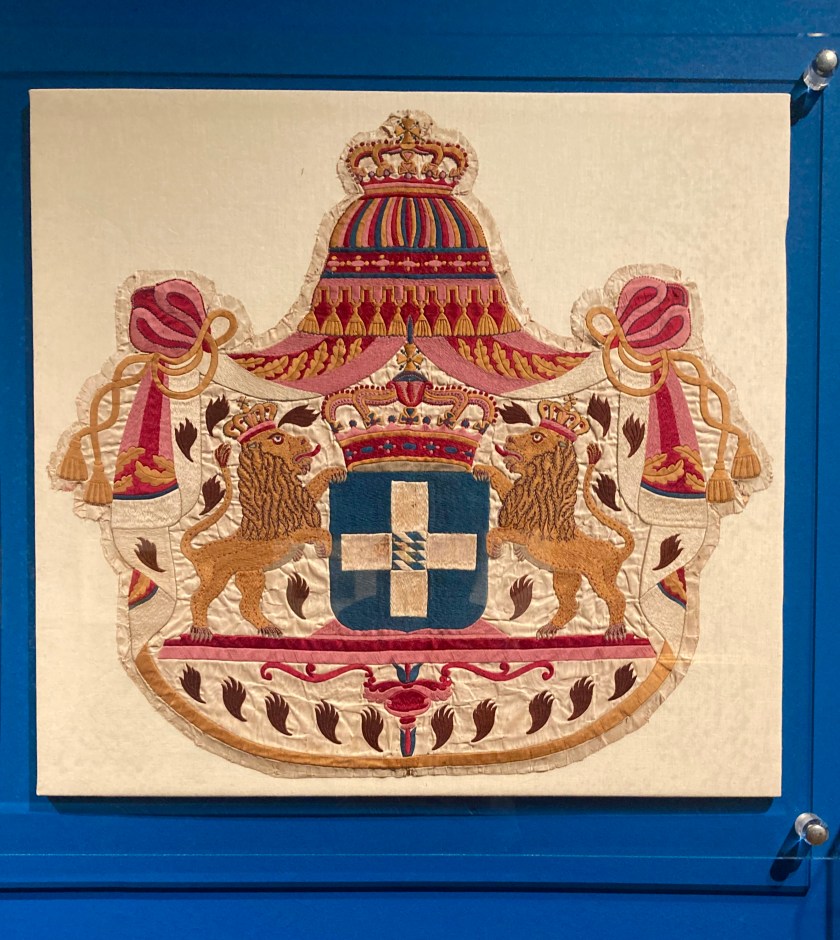Some weeks ago I finally managed to go and see the wonderful exhibition celebrating the 200th anniversary of the Greek Revolution, at the Benaki Museum in Athens. The modern Greek state, as those of you who read my post(Here) on its 200th anniversary will know, was formed after the revolution which started in 1821 and liberated Greece from four centuries of occupation by the Ottoman Empire.
Below is a wonderful scroll depicting the city of Constantinople (Istambul today)
The exhibition “1821 Before and After”, brings to life more than 100 years of history (1770-1870), and includes paintings, sculptures, personal items belonging to key revolutionaries, maps, historic documents and heirlooms.

During those years, the Greek-speaking Christian Orthodox subjects of the Ottoman Empire retained their language, religion and customs, despite a strong Turkish presence. There was also a lively cultural exchange between the Empire’s various ethnic groups and nationalities—Turks, Jews, Armenians and others. This coexistence resulted in an indirect exchange of customs. Other regions, such as the Ionian islands, which never experienced Ottoman rule, nevertheless enjoyed powerful Western influences.

I shall not attempt to explain the very complicated history of those times, nor take you through the entire exhibition, which is huge, but just show you some of my favourite pieces in an attempt to give you a flavour of that era in Greece.

The Greeks developed a powerful, armed merchant fleet, trading primarily with the Russian Empire, whose protection it enjoyed.

Traders imported foreign goods such as luxury fabrics from Europe and silk thread, resulting in sophisticated fashions.

The dress above is from the island of Andros and the one below from Crete (late 17th-early 18th century)

Two small boys in their best clothes:

And an intricately embroidered bed curtain:

There are multiple portraits of the heroic fighters of the revolution, such as the one of Marcos Botsaris below:

And of course, the romantic figure of Lord Byron, who famously took up the Greek cause and died of fever at Messolonghi.

The battles and naval battles of the Revolution were well documented. The Battle of Samos, below, is a watercolour by an unknown artist.

Scenes of daily life and stories of the struggle were depicted by many artists, such as the primitive artist Theophilos.

After the liberation, the Great Powers (England, France and Russia) sent Otto (Otho) the second son of King Ludwig I of Bavaria, to be the new country’s king. He was 17. Needless to say, the politics and jockeying for position of the various factions were too complicated to go into here.

Otto declared Athens his capital and brought over a team of German architects to transform what was but a village at the foot of the Acropolis into a city. These neoclassical buildings remain the most beautiful in the city today.

Construction under way

 As well as telling the fascinating story of the formation of a modern state out of nothing, the exhibition also, in my opinion, sheds light on many aspects of today’s Greece: it is a very young country still, built upon shaky foundations. Its continued dependence upon the invaluable help of the Allies—England, France and Russia—and the resulting geopolitical manoeuvring as well as the usual internal conflicts had repercussions which still wield their influence today.
As well as telling the fascinating story of the formation of a modern state out of nothing, the exhibition also, in my opinion, sheds light on many aspects of today’s Greece: it is a very young country still, built upon shaky foundations. Its continued dependence upon the invaluable help of the Allies—England, France and Russia—and the resulting geopolitical manoeuvring as well as the usual internal conflicts had repercussions which still wield their influence today.



Just the textiles alone would have made this exhibition worth visiting, but there’s such a wealth of material to enjoy, it would demand several visits…
LikeLike
Yes, there was nearly too much to take in. Amazing the clothes they wore when you think Greece was just a backwater then, and means of communication very limited. The beauty of trade.
LikeLiked by 1 person
Thanks for this fascinating tour, Marina. Modern Greece is indeed a young country, but the Ancient Greeks gave us so many of the foundations of western society.
Best wishes, Pete.
LikeLiked by 1 person
Thank you, Pete. I’m glad you enjoyed it. 🍁
LikeLike
Wonderful exhibition. Thank you for flagging it up.
And I am so glad that us ladies from Andros get the chance to dress up sometimes !
LikeLike
Yes, absolutely wonderful embroidery❤️
LikeLike
This posting is fantastic, thanks Marina. Well, the exhibition is fantastic too! I wouldn’t mind further presentations of it!!
LikeLike
Glad you enjoyed it, Bruce. It was not very easy taking photos in that light, a lot didn’t come out well.
LikeLiked by 1 person
Thank you for taking us along to this exhibit both as an overview and an encouragement to do our own further research. I freely admit to ignorance of Greek history but relish the opportunity to learn in thus fashion . . . on a light note – to think such beautiful materials were available for ladies of wealth some four hundred years back does pit some matters into perspective . . .
LikeLike
Yes,doesn’t it? Trade—and immigration—go a long way back…
LikeLike
I am surprised that modern Greece is such a young country. I suppose I thought that the traditions/concepts from ancient times, like democracy, just flowed through. It was fascinating to get the snippet of history. As Kate says, this exhibition would need many visits to absorb it all.
LikeLike
Well we are very proud of our ancestry and I some things do flow through. But not as regards the institutions and trappings of a modern state….
LikeLike
How wonderful!
LikeLiked by 1 person
Fantastic you were able to get to see the exhibition! (Downunder we’re still not permitted overseas travel) Thanks for your photos.
LikeLike